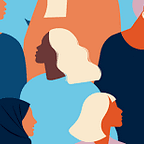What do we want to answer? 🙄
Hi everyone !!! We want to tell you that after doing the whole process of design thinking we have been through a lot of doubts regarding what is we want to answer truly with our data. We had 5 initial questions but as we moved in the creative process of designing our visualizations, we noted that we had to reformulate some questions because they weren’t so clear. Finally, we decided to answer the following:
· How have laws evolved over the last fifty years toward greater gender equality?
This is one question that remained as we proposed originally because undoubtedly we want to know how the laws have changed in the last fifty years. We are expecting to find that laws have improved in gender equality as the world keeping forward. In order to answer this question, we are going to explore the WBL Index through time, not just comparing it between the 7 regions that our dataset has but also by the countries inside of each one. We are aware that would be unfair to treat the whole 190 economies with the same weight, knowing the level of development of each one is tied up to specific conditions of their regions. We hope show a visualization like this:
· How much have the economies developed in gender legal equality according to their income group?
We also notice that an important analysis we have to do is studying the WBL Index by the 4 income groups available in our dataset. After exploring our data, we saw that maybe the countries inside of each region were not fully comparable between them because, in our prior knowledge, we consider each one has differences economically speaking, despite belonging to the same classification. Hence, we decided to analyze the WBL Index not just by region but also by the different income groups inside of each one. We are expecting the following visualization:
· How does each indicator influence a woman’s independence currently?
As we mentioned in previous blogs, our dataset has information about 8 indicators and each one was constructed by different questions, for instance, one indicator is ‘Marriage’ and it has the 5 following questions:
- Is there no legal provision that requires a married woman to obey her husband?
- Can a woman be head of household in the same way as a man?
- Is there legislation specifically addressing domestic violence?
- Can a woman obtain a judgment of divorce in the same way as a man?
- Does a woman have the same rights to remarry as a man?
We want to compare the 10 best-ranked countries in WBL Index against the 10 worst-ranked ones in the last year, and analyze them by each indicator, and understand what questions make them different. In this way, we could answer what makes a woman independent and also in which countries a woman can live her true independence and in which not. We imagine a visualization like this:
· How do the regulations influence women’s life?
After the previous question, we thought that would be amazing to analyze the top five or ten countries that have had the greatest advance in the WBL Index from the first year of study to currently, i.e. those who have made the most significant leap. We want to study them over time and discover what regulations were applied and in what period, in this way, we could answer how the laws have influenced women’s lives and which ones have contributed the most. Get the next visualization would be a great success:
· What is the relationship between the dimensions?
Finally, we would like to evaluate the relationship between dimensions through some statistical analysis. We are curious about how is the relationship between all questions in the dataset, and maybe we might discover different dimensions to those of the World Bank Group but it’s just an idea. We imagine the next visualization under the assumption that we have the time to make it, and also we get something interesting in the statistical study of course:
